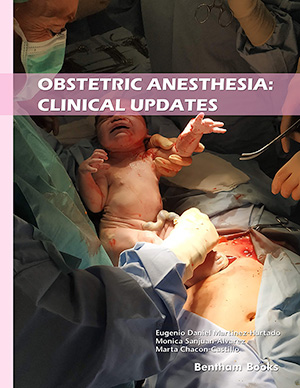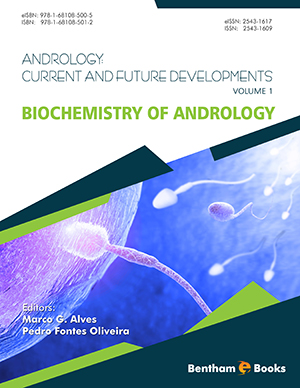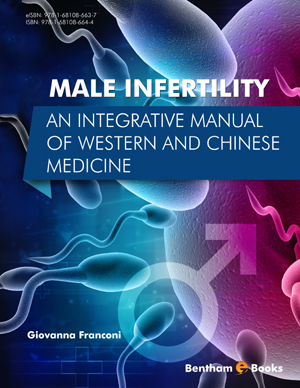Book Volume 4
Preface
Page: i-i (1)
Author: Eugenio Daniel Martínez Hurtado, Monica San Juan Álvarez and Marta Chacón Castillo
DOI: 10.2174/9789815041841122040001
Fetomaternal Physiology: Physiological Changes during Pregnancy
Page: 1-13 (13)
Author: Adriana Carolina Orozco Vinasco*, Mónica San Juan Álvarez and David Orozco Vinasco
DOI: 10.2174/9789815041841122040003
PDF Price: $30
Abstract
Anesthesia during pregnancy is challenging due to the extreme physiological
and anatomical changes that occur. Deep knowledge of these changes and how they
influence anesthesia is critical in order to offer safe anesthetic care to both, mother and
the child. In this chapter, we will review the main features that occur in the respiratory,
cardiovascular, central nervous, renal, and gastrointestinal systems, among others, and
how it affects pharmacodynamics, pharmacokinetics, airway management and conduct
of anesthesia. Fetomaternal circulation and fetal physiology focused on anesthesia will
also be discussed.
Safety in the Obstetric Patient: Simulation Training for Anesthesiologists in the Obstetrics Field
Page: 14-32 (19)
Author: Pilar Hernández Pinto*, Marta López Doueil, Rodrigo Sancho Carrancho and Marta María Galnares Gómez
DOI: 10.2174/9789815041841122040004
PDF Price: $30
Abstract
The principal goal of health systems is to provide safe and quality healthcare
for the patient. Deficiencies in the environment in which obstetric care is provided,
inadequate teamwork and communication, and poor individual performance during
emergencies have been identified as preventable causes of harm to obstetric patients.
There is growing evidence about training in Emergency Obstetric Care (EmOC) that
reduces the risk of maternal and newborn mortality and morbidity. The Institute of
Medicine identifies team-based training and simulation as methods to improve patients’
safety, especially in the obstetrics field, these may add value to it. Recent research
works review the effectiveness of training in EmOC and the use of simulation in
improved health outcomes. It remains unclear whether this translates into improved
patient outcomes.
Airway Management in Pregnancy
Page: 33-56 (24)
Author: Eugenio D. Martinez Hurtado*, Laura Reviriego Agudo, Pedro Charco Mora, Miguel Ángel Fernández Vaquero and María Gómez Rojo
DOI: 10.2174/9789815051841122040005
PDF Price: $30
Abstract
Airway management in the obstetric patient is a challenge for
anaesthesiologists, not only because of the anatomical and physiological changes
during pregnancy, but also because of the surgery´s urgency, the location of the
procedure, which sometimes takes place even outside the operation theatre, and also
due to conflicts emerging between the needs of the mother and fetus. The arising
maternal comorbidities such as obesity, contribute to complications in airway
management in this population.
Anesthesia for Fetal Surgery
Page: 57-66 (10)
Author: Marta Chacón Castillo*, Natalia Martos Gisbert and Adriana Orozco Vinasco
DOI: 10.2174/9789815051841122040006
PDF Price: $30
Abstract
Fetal surgery has evolved in the last decades, mostly because of the
technical advances in therapeutic and monitoring devices. The timing and mode of
surgery depend on the disease to be treated. Local, neuraxial or general anesthesia can
be used on the mother. In some cases, fetal analgesia and paralysis are needed.
The idea of treating the fetus as a patient has evolved in recent years, as a consequence
of improvements in diagnostic imaging and surgical devices. In fetuses with congenital
airway obstruction, intrapartum surgical correction or airway management can be
performed while maintaining perfusion via the umbilical cord.
In 1980, maternal laparotomy and hysterotomy were proposed to treat fetuses with
congenital and developmental abnormalities, and the prerequisites for maternal-fetal
surgery were first formulated in 1982. They are still in use with some minor
modifications. A multidisciplinary approach to fetal intervention is essential. Both
obstetric and pediatric anesthesia is involved and it a close collaboration with surgical
teams is necessary.
Regional and Parenteral Analgesia in Labour
Page: 67-84 (18)
Author: Monir Kabiri Sacramento*, Javier Alcázar Esteras, Patricia Alfaro de la Torre, Sergi Boada Pie and Miriam Sánchez Merchante
DOI: 10.2174/9789815051841122040007
PDF Price: $30
Abstract
Labour pain is a complex phenomenon involving subjective psychological factors and physiological neurohormonal factors. Many different factors contribute to the perception of pain: cultural factors, bond, and trust in the delivery team, being able to take their own decisions, relaxation ability, previous labour, anatomical and fetalrelated factors. Pain relief is one of the elements involved in overall satisfaction but it is not the only one and is important to remember that pharmacological intervention is only a part of it.
Local Anesthetics and Adjuvants for Labor: Local Anesthetic Systemic Toxicity
Page: 85-99 (15)
Author: Patricia Alfaro de la Torre*, Monir Kabiri Sacramento, Irene Riquelme Osado and Rosa Fernández García
DOI: 10.2174/9789815051841122040008
PDF Price: $30
Abstract
The choice of drugs used during labor is almost as important as the analgesic
technique selected since effective pain relief contributes directly to satisfaction: the
better the pain relief, the higher the satisfaction. Although bupivacaine has traditionally
been the most widely used local anesthetic, L-bupivacaine and ropivacaine have similar
action profiles with a lower risk of cardiovascular and neurologic toxicity and
especially less motor blockade, when used under low-concentration strategies. The use
of adjuvants, especially opioids, allows us to improve the analgesic quality while
reducing the total dose of local anesthetics, although their use should be individualized,
and patients should be monitored and treated for side effects if they appear.
Anesthesia for Cesarean Section
Page: 100-110 (11)
Author: Mónica San Juan Álvarez*, Adriana Orozco Vinasco, Marta Chacón Castillo and Juan José Correa Barrera
DOI: 10.2174/9789815051841122040009
PDF Price: $30
Abstract
Caesarean section is the most frequently performed surgery in adults, with a
total of 20 million procedures per year. More than 70% of cases are due to lack of labor
progression, fetal distress, breech presentation or previous cesarean section.
Obstetric anesthesia practice has substantially changed over the last 20 years. The main
cause of this is the introduction of regional techniques to the detriment of general
anesthesia, which has reduced maternal mortality due to complications such as gastric
aspiration or difficulty in orotracheal intubation. In general, we can affirm that regional
anesthesia is the most frequently used anesthetic technique for cesarean section,
reserving general anesthesia for urgent or life-threatening situations.
Locoregional Anesthesia Comments in the Obstetric Patient and Eventual Complications
Page: 111-131 (21)
Author: María Mercedes García Domínguez*, Carlos Hugo Salazar Zamorano, Eugenio Martínez Hurtado and Miriam Sánchez Merchante
DOI: 10.2174/9789815051841122040010
PDF Price: $30
Abstract
Labor pain is associated with increased stress response and when it is
excessive, it may lead to hypoxemia and fetal acidosis. The most important factor in
obstetric analgesia is the desire for pain relief by the patient and neuraxial analgesia is
the mainstay procedure in labor and in anesthesia for cesarean delivery. Continuous
lumbar epidural analgesia is the mainstay of neuraxial labor analgesia. There are other
methods, such as intrathecal block or combined spinal-epidural, that can be useful in
specific cases. Despite being the safest and most effective method, the epidural labor
analgesia may have some complications. Other therapies include bilateral paracervical
block and pudendal block, which provide rapid onset analgesia (2–5 min). Although
useful, they require training and are risky in cases of placental insufficiency or
prematurity.
Uterotonic Agents
Page: 132-145 (14)
Author: Juan José Correa Barrera*, Blanca Gómez del Pulgar Vázquez, Adriana Orozco Vinasco and Enrique Alonso Rodríguez
DOI: 10.2174/9789815051841122040011
PDF Price: $30
Abstract
Postpartum haemorrhage due to uterine atony is one of the major causes of
maternal morbidity and mortality worldwide. Different control strategies have been
postulated, especially during the third stage of labour, but the gold standard treatment is
the use of uterotonic drugs. There are currently three well-defined groups of drugs:
oxytocics, ergot derivatives and prostaglandins. Although the literature is
heterogeneous, it is clear that oxytocin is the uterotonic of choice in both prophylaxis
and treatment of postpartum haemorrhage. Detailed knowledge of protocols based on
current evidence is mandatory, which vary according to the different medical societies
and dictate the doses and order of administration of different drugs.
Anesthesia for Non-Obstetric Surgery in Pregnancy
Page: 146-160 (15)
Author: Irene González del Pozo*, Inés Almagro Vidal and Paula Agostina Vullo
DOI: 10.2174/9789815051841122040012
PDF Price: $30
Abstract
The need for non-obstetric surgery during pregnancy is relatively frequent
and can occur at any time during pregnancy. In this chapter, we will develop the
anesthetic implications of changes in maternal physiology, and the repercussions of
anesthesia on the fetus, and we will delve into the peculiarities of anesthetic
management of these patients. Urgent/emergent procedures should not be postponed in
these patients due to their pregnancy conditions. However, elective surgeries should be
delayed whenever possible, taking into account the maternal-fetal risk-benefit.
Anesthetic Management of the Pregnant Patient with Comorbidities
Page: 161-175 (15)
Author: Anna Pascual Carreño*, Aleix Clusella Moya, Mireia Pozo Albiol, Eva Maria Blazquez Gomez and Esperanza Martin Mateos
DOI: 10.2174/9789815051841122040013
PDF Price: $30
Abstract
An increase in pregnant patients with comorbidities has been seen in the last
decade. Nevertheless, these patients are able to enjoy longer and better quality lives
nowadays. During pregnancy, patients can experience decompensations of their chronic
disease which can be sometimes challenging for the medical team. Complexity has
risen; that is why the anesthesiologist must be updated and capable of facing different
scenarios both in the delivery room and before or after birth.
This chapter offers a practical and synthetical approach to the most common situations
in which a general anesthesiologist can be involved, aiming to emphasize main points
for safe and accurate anesthetic care.
Anesthetic Management of Pregnant Patients with Infectious Disease
Page: 176-193 (18)
Author: Serafín Alonso Vila*, Elena Suárez Edo, Elena Sánchez Royo, Anna Conesa Marieges and Susana Manrique Muñoz
DOI: 10.2174/9789815051841122040014
PDF Price: $30
Abstract
Fever is often the result of an infection. The most common sites for infection
during pregnancy are fetal membranes, urinary and respiratory tracts, and the
postpartum uterine cavity. The most frequent etiologies of intrapartum fever are
chorioamnionitis and neuraxial anesthesia. Maternal and fetal exposure to hyperthermia
and inflammation is associated with adverse consequences for the mother and the
neonate. In pregnant women with fever, anesthesiologists are not only involved in
providing analgesia, but also in the correct anesthetic management for the surgical
treatment of the infectious region. Thus, as pyrexia may change both obstetric and
anesthetic management, preventing maternal fever is imperative. Emerging and
challenging infectious diseases, as COVID-19, remind us of the susceptible nature of
pregnant and early postpartum women to severe respiratory infections, reinforcing the
importance of vaccines and therapeutic measures during pregnancy.
Obstetric Hemorrhage
Page: 194-203 (10)
Author: María de la Flor Robledo* and Pablo Solís Muñoz
DOI: 10.2174/9789815051841122040015
PDF Price: $30
Abstract
Postpartum hemorrhage (PPH) is the most common cause of obstetric
hemorrhage (OH) and the first cause of maternal death worldwide. However, its
mortality has decreased in the United States in recent decades due to the
implementation of certain measures. Several factors are significantly associated with
the onset of PPH. Identifying them early will help us to establish an appropriate
strategy for the management of these patients. One of the most useful prevention
measures is the active management of the third stage of labor, especially the routine
administration of oxytocin. The existence of acting algorithms will also contribute to a
rapid and orderly response to the presence of expected or unplanned bleeding.
Hypertensive Disorders in Pregnancy
Page: 204-257 (54)
Author: Eugenio D. Martinez Hurtado* and Míriam Sánchez Merchante
DOI: 10.2174/9789815051841122040016
PDF Price: $30
Abstract
Due to the high risk of morbidity and mortality in pregnant women with
unrecognised and untreated preeclampsia, a high index of suspicion for signs of
preeclampsia should be used to evaluate, treat and monitor patients. Early blood
pressure control and seizure prophylaxis during labour are essential to ensure maternal
safety. However, a limited proportion of pregnancies and deliveries may present a wide
range of complications that may require admission to a critical care unit (CCU).
Hypertensive disorders of pregnancy and massive hemorrhage are among the most
common causes of admission to the CCU in pregnant and post-partum women.
Air and Amniotic Fluid Embolism
Page: 258-267 (10)
Author: Clara Isabel Fernandez Sánchez*, Adriana Carolina Orozco Vinasco, Monica San Juan Alvarez and Marta Chacón Castillo
DOI: 10.2174/9789815051841122040017
PDF Price: $30
Abstract
Amniotic fluid embolism (AFE) is an uncommon pathology, whose
incidence ranges from 2 to 8 per 100,000 births, depending on the country. This
syndrome has four cardinal symptoms: circulatory collapse, respiratory distress,
cyanosis and coma. If the patient survives cardiorespiratory failure, disseminated
intravascular coagulopathy occurs, leading to incoercible bleeding and eventually
death. Clinical diagnosis is based on Clark's four criteria: sudden cardiorespiratory
arrest, established disseminated intravascular coagulation prior to bleeding, and all of
these occurring peripartum in the absence of fever. The two main differential diagnosis
syndromes are pulmonary thromboembolism and myocardial infarction. Treatment
consists of cardiopulmonary support of the patient. Despite aggressive measures, such
as the placement of ventricular assist devices and external oxygenation membranes, the
prognosis continues to be poor. The main death cause is incoercible bleeding caused by
disseminated intravascular coagulopathy.
Postoperative Management of Postnatal Complications
Page: 268-282 (15)
Author: Ligia María Pérez Cubías*, Yobanys Rodríguez Téllez, Carolina Forero Cortés and Clara Hernández Cera
DOI: 10.2174/9789815051841122040018
PDF Price: $30
Abstract
The postpartum period is the time after delivery when physiological changes
by the pregnancy return to the previous state. Primary postpartum haemorrhage takes
place during the first 24 hours, and secondary postpartum haemorrhage occurs between
24 hours and 6 weeks after delivery.
Many disorders can occur in the immediate postpartum period, there is a considerable
source of morbidity and mortality in women of reproductive age, which can be mild to
severe and life-threatening.
Protocols aimed at the multidisciplinary management of postpartum haemorrhage, and
together with the use of coadjuvant hemostatic agents, the activation of massive
transfusion protocols in a responsible manner, and surgical management have improved
the prognosis of these patients.
Analgesia after Labor and Cesarean Section: Chronic Pain after Pregnancy
Page: 283-304 (22)
Author: Carmen Gomar Sancho*, Ana Plaza Moral, Marina Vendrell Jordà, Antonio López Hernández and Irene León Carsí
DOI: 10.2174/9789815051841122040019
PDF Price: $30
Abstract
Chronic pain (CP) conditions after childbirth include persistent pain after
caesarean section (CPCS), perineal pain after instrumental vaginal delivery, lower back
pain and pelvic girdle pain. Any type of CP before or during pregnancy increases the
risk of CP after delivery. Scar pain is the most recognized etiology for CPCS with a
neuropathic component, although it is less frequent than in other surgeries. Reported
CPCS incidence ranges from 1 to 23%. Pain intensity is moderate and decreases with
time in all studies. The severity and duration of peripartum pain are the main risk
factors for CP and its control is the most recommended strategy for reducing risk. Fear
of fetal and neonatal adverse events means that CP is often undertreated, but after
delivery, pharmacological restrictions disappear and many pain drugs are compatible
with breastfeeding. Education of obstetric teams about early detection and referral to
specialized consultation of women with CP is the key. In this chapter, available
information in the recent literature, mainly during the last years, is presented. This
chapter focuses on CP conditions after childbirth, as analgesia for labor and childbirth
and immediate pain after CS and vaginal delivery are covered in other chapters of this
book.
Anesthesia for Assisted Reproduction
Page: 305-321 (17)
Author: Montserrat Franco Cabrera*, Daniel Vieyra Cortés, Aniza S. González Lumbreras and Luis Humberto García Lorant
DOI: 10.2174/9789815051841122040020
PDF Price: $30
Abstract
Infertility is a common aspect globally affecting couples to 15%, and it is
frequently increasing the need for anesthesiologists’ participation in assisted
reproductive techniques.
Currently, the procedures used to assist reproduction are unable to fully cover the
detrimental effects of age. During anesthesia-analgesia in oocyte retrieval, the role of
the anesthesiologist is to provide the patient with adequate anxiolysis, analgesia, and
sedation as the key to success in the procedure. An adequate pre-anesthetic assessment
is required to identify derivative diseases and take the appropriate care of each patient.
Modern anesthetic techniques for oocyte retrieval include conscious sedation, general
anesthesia, regional anesthesia, and other alternative techniques, such as
electroacupuncture, or even a combination of these.
In this chapter, the main characteristics of these techniques will be exposed, as well as
their complications and the recommendations so that anesthetic procedures are safe not
only for the patient, but also for the whole process’ success.
Anesthetic Management for External Cephalic Version
Page: 322-332 (11)
Author: María Luz Serrano Rodriguez*, Sara Hervilla Ezquerra, Laura Fernandez Tellez, Andrea Alejandra Rodriguez Esteve and Marta Chacon Castillo
DOI: 10.2174/9789815051841122040021
PDF Price: $30
Abstract
Approximately 3% to 4% of term fetuses are in breech presentation, and this
is a common indication for cesarean delivery. Twenty percent of elective cesarean
sections are due to breech position.
External cephalic version (ECV) is an obstetric maneuver that applies external pressure
to the fetal posture through the maternal abdomen, to convert a breech presentation to a
vertex presentation. Since the risk of adverse events after an ECV is small, the
possibility of ECV should be offered in all pregnancies with breech presentation,
provided that there is no contraindication.
A standardized protocol, an experienced gynecologist and adequate analgesia can
facilitate the maneuver and improve the success rate, turning the ECV into a maneuver
with an excellent safety profile which is an interesting option to avoid a cesarean
section.
Mindfulness-Based Interventions during Pregnancy and Labour
Page: 333-380 (48)
Author: Míriam Sánchez Merchante* and Eugenio D. Martinez Hurtado
DOI: 10.2174/9789815051841122040022
PDF Price: $30
Abstract
During pregnancy, events occur that can negatively affect a woman's mental
health, such as vaginal bleeding, concern for the health of the fetus, decreased fetal
movements, ultrasound results, or fear of childbirth itself. Pregnant women must be
able to cope with these stressful events, as perinatal mental health problems can have
adverse consequences for both parents and babies.
Psychological disturbances in the mother during pregnancy can adversely affect the
development of the fetus, leading to long-term negative effects on the health of the
child. It is therefore important to identify prenatal interventions that can reduce this
maternal distress, and one possible approach to address these perinatal mental health
difficulties is mindfulness-based interventions.
Subject Index
Page: 381-386 (6)
Author: Eugenio Daniel Martinez-Hurtado, Monica Sanjuan-Alvarez and Marta Chacon-Castillo
DOI: 10.2174/9789815051841122040023
Introduction
In recent years, we have witnessed significant advances in obstetric anesthesia, providing greater safety for the mother and the fetus, as well as an improvement in pain management procedures during labor. This volume presents updates in obstetrics and gynecology that are reflective of the changes in the demographics and associated clinical presentations of gynecological pathologies. It compiles state of the art information on the subject in 20 chapters contributed by more than 50 experts in obstetric anesthesia. The main objective of this volume is to inform and update readers about the different aspects essential to the practice of anesthesia and analgesia during pregnancy, labor, cesarean section and puerperium. The contents also include information about the management of pregnant women with different pathologies and high-risk pregnancies. The authors believe that it is essential for all anesthesiologists to be aware of the latest advances and well-contrasted scientific evidence that will allow them to carry out their usual clinical activity. The volume approaches the subject in a clear and didactic way for the benefit of all professionals involved in this field, including anesthesiologists, gynecologists, obstetricians, surgeons, clinicians and allied healthcare service providers.







 Download PDF File
Download PDF File










